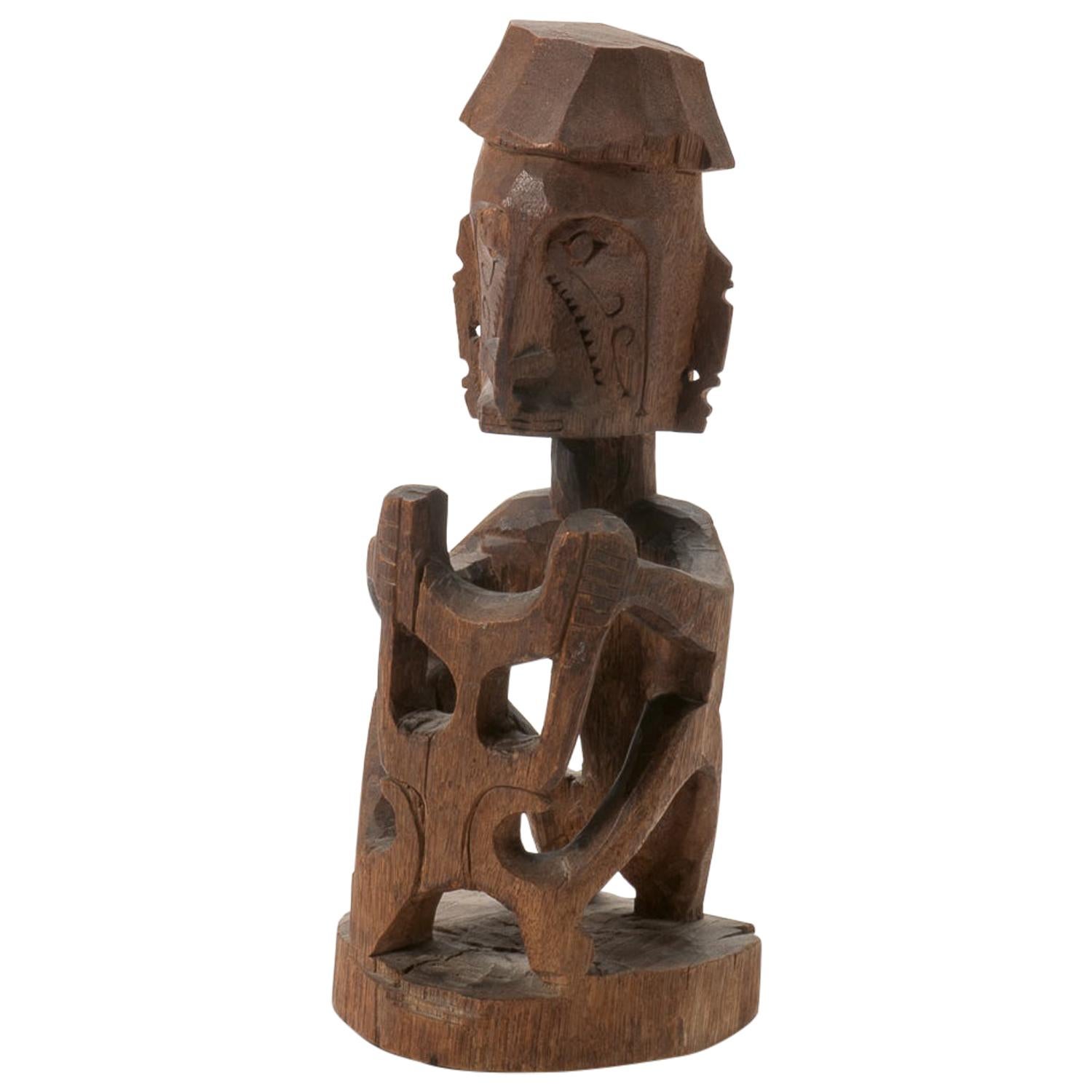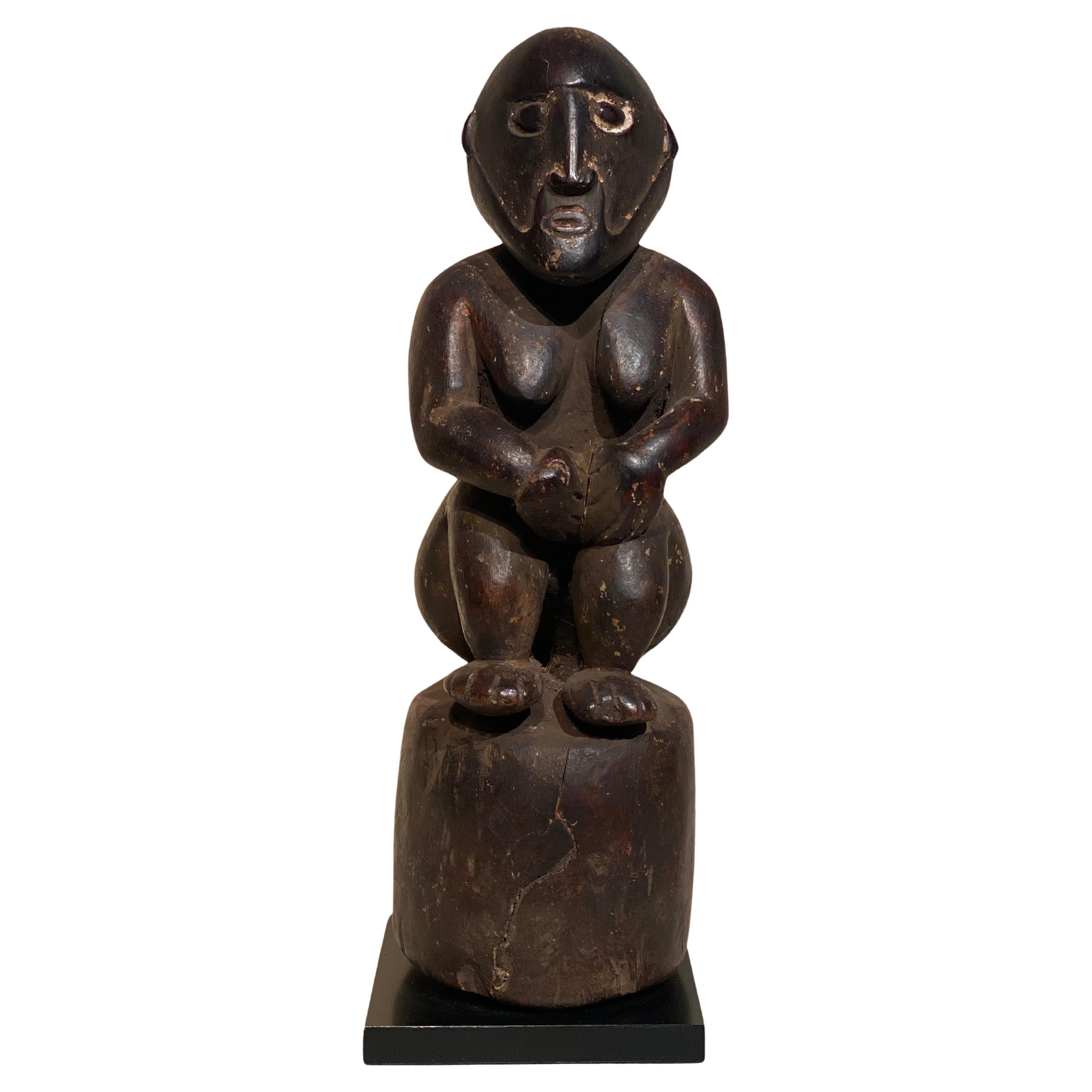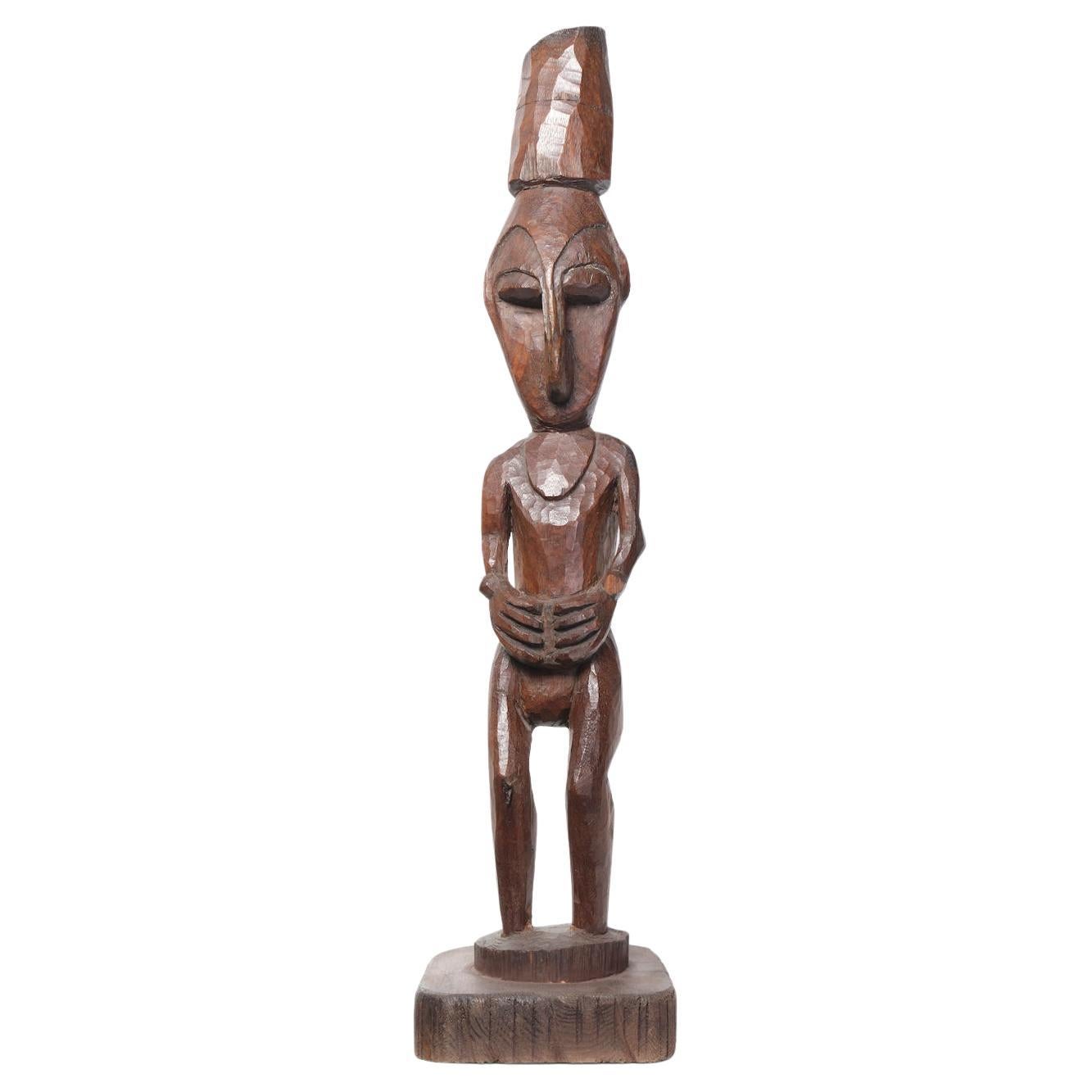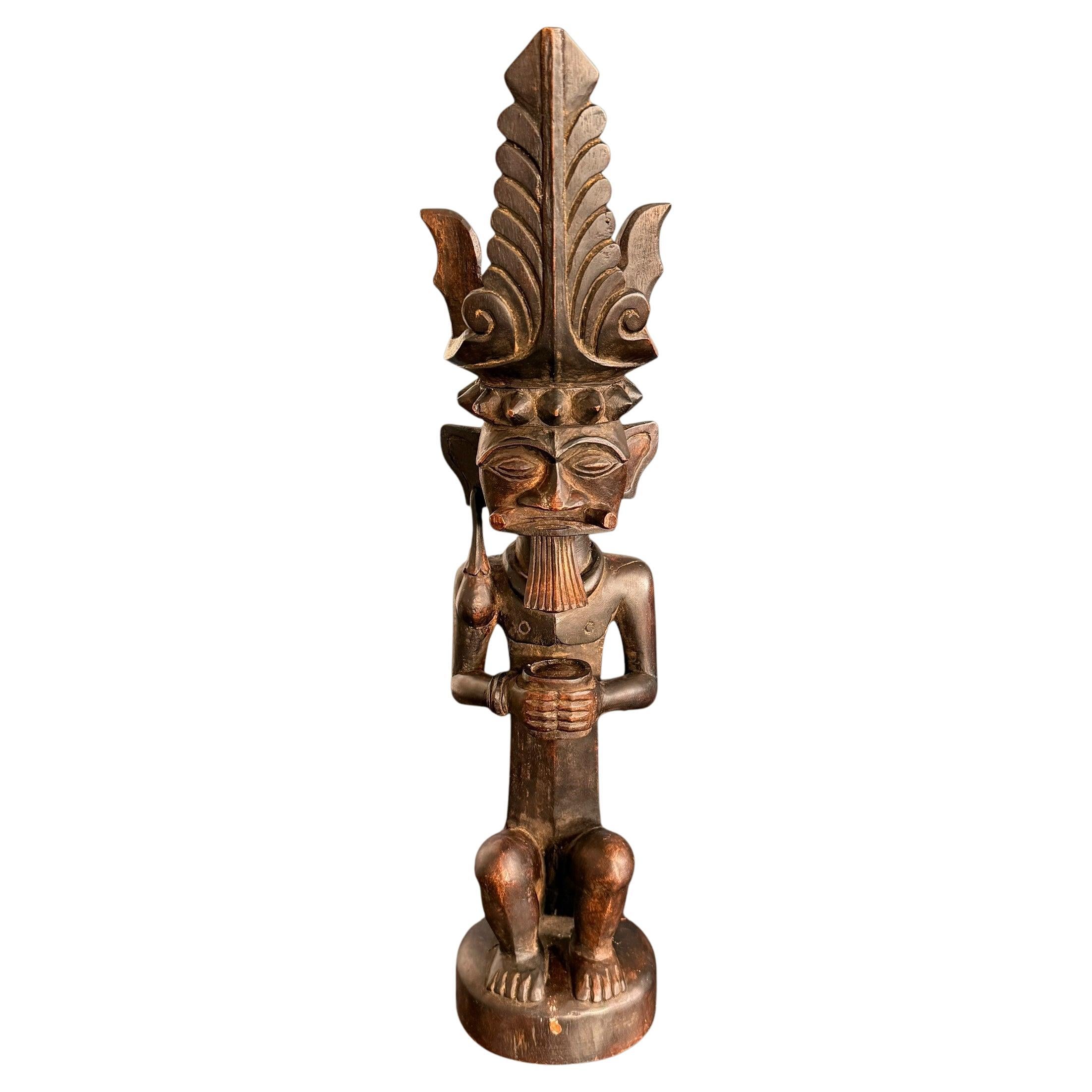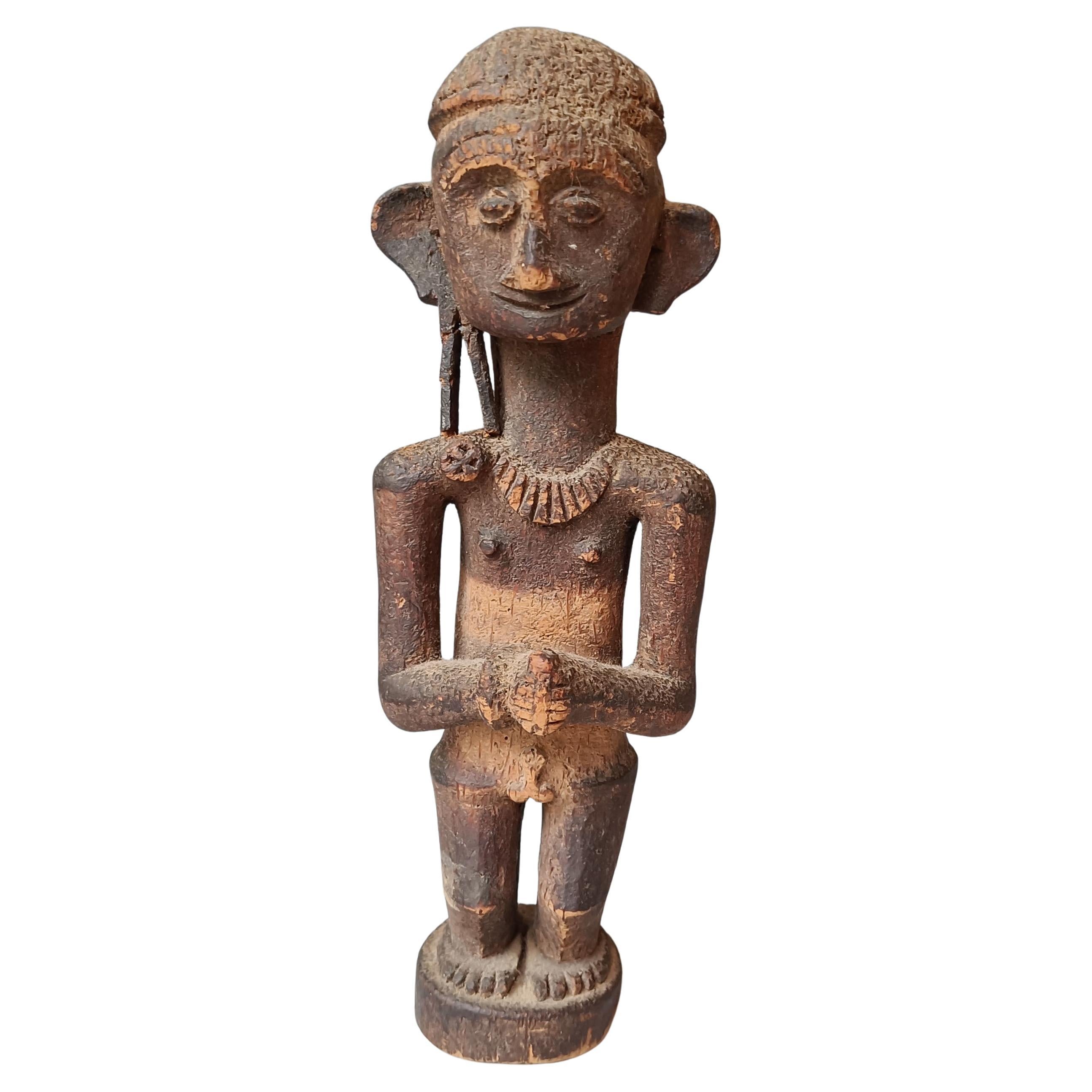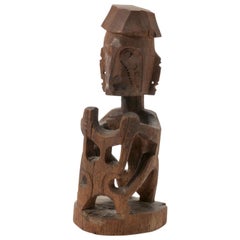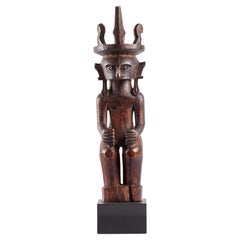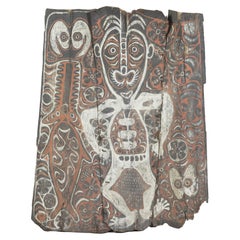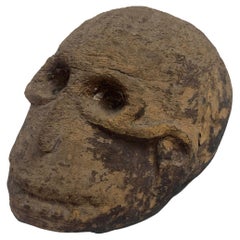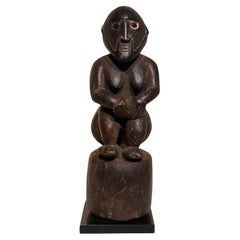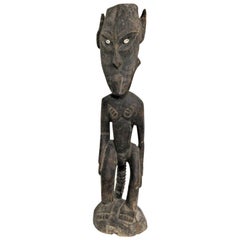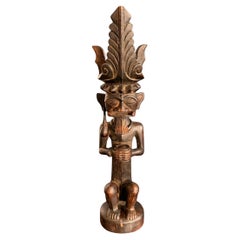Items Similar to Early Papua Korwar Ancestor Figure, Early 19th Century, Deep Black-Brown Patina
Want more images or videos?
Request additional images or videos from the seller
1 of 9
Early Papua Korwar Ancestor Figure, Early 19th Century, Deep Black-Brown Patina
$113,823.64
£84,734.30
€95,000
CA$155,909.93
A$173,405.88
CHF 90,547.16
MX$2,110,165.09
NOK 1,156,425.42
SEK 1,084,523.03
DKK 723,201.83
Shipping
Retrieving quote...The 1stDibs Promise:
Authenticity Guarantee,
Money-Back Guarantee,
24-Hour Cancellation
About the Item
An extremely rare Papua wood sculpture of a Korwar
Papua New Guinea, Cendrawasih Bay, Wandammen, early 19th century
Measures: Height 24 x Diameter 18 cm
Finely carved in the early style, the figure seated on a circular base, with elongated head, detailed facial expression with blackened eyebrows, lashes, mustache and teeth, the ears and forehead pierced, all areas facing upwards with a deep black-brown patina of usage and insect droppings.
With a hand-written label to the bottom stating Korwar Patoeng Nenek- Mojang Orang Papua. Inscribed Biak Papua on the forehead and indistinctly inscribed in French on the back of the head.
This rare type of Korwar belongs to the earliest pieces known to exist, as stated in Dr. Oskar Nuoffer, Ahnenfiguren von der Geelvinkbai, Hollandisch Neuguinea, Leipzig 1908 (ill. 5 & 6) and in De Clercq & Schmeltz, Etnographische beschrijving van de west en noordkust van Nederlands New Guinea, 1893 (ill. 1 & 7).
For a comparable Korwar probably by the same carver, from the collection of the Museum of World Cultures in Rotterdam, see: R. Corbey, Northwest New Guinea Ritual Art according to missionary sources, Leiden 2019 (ill. 122). For further reading and more comparable Korwar, see beforementioned book pp. 148-155 and Van Baaren, Korwars and korwarstyle, 1968 (ill. 32, 33 & 48).
The patina and smooth surface of the Korwar as a result of handling over a long period of time acknowledges the fact that this Korwar dates from the early 19th century.
Most Korwar figures were made for the families of sick or deceased males, and occasionally females, during illness or immediately following their death. During the carving, chants were sung to assure that the spirit power of the ancestor would enter into the figure. The figures then served as intermediaries between the living and the dead. Their advice was sought through the actions of a shaman who went into a trance and was then able to pass on the words of the spirit to the living descendants.
Provenance: by repute bought by a pioneer of Royal Dutch Shell (Multinational Oil and Gas Company) in a shop in Jakarta in the early 20th century, who later lived in a stately home along the river Vecht, thence by descent.
We are grateful to Mr. Peter van Drumpt for is assistance in writing this catalogue entry.
- Dimensions:Height: 9.45 in (24 cm)Diameter: 7.09 in (18 cm)
- Style:Tribal (Of the Period)
- Materials and Techniques:
- Place of Origin:
- Period:
- Date of Manufacture:1800-1820
- Condition:Wear consistent with age and use.
- Seller Location:Amsterdam, NL
- Reference Number:1stDibs: LU5458222093232
About the Seller
5.0
Recognized Seller
These prestigious sellers are industry leaders and represent the highest echelon for item quality and design.
Established in 1985
1stDibs seller since 2020
23 sales on 1stDibs
Typical response time: 2 hours
- ShippingRetrieving quote...Shipping from: Amsterdam, Netherlands
- Return Policy
Authenticity Guarantee
In the unlikely event there’s an issue with an item’s authenticity, contact us within 1 year for a full refund. DetailsMoney-Back Guarantee
If your item is not as described, is damaged in transit, or does not arrive, contact us within 7 days for a full refund. Details24-Hour Cancellation
You have a 24-hour grace period in which to reconsider your purchase, with no questions asked.Vetted Professional Sellers
Our world-class sellers must adhere to strict standards for service and quality, maintaining the integrity of our listings.Price-Match Guarantee
If you find that a seller listed the same item for a lower price elsewhere, we’ll match it.Trusted Global Delivery
Our best-in-class carrier network provides specialized shipping options worldwide, including custom delivery.More From This Seller
View AllEarly Papua Korwar Statue, Collection of Missionary Starrenburg, Collected 1909
Located in Amsterdam, NL
A Papua wood figure of a Korwar
North West Irian Jaya, Vogelkop area, coastal Geelvink Bay, present-day Cenderawasih Bay, early 20th century
The seated Korwar is holding an ope...
Category
Early 20th Century Indonesian Tribal Tribal Art
Materials
Wood
A Nias 'Adu Zatua' wooden ancestor sculpture
Located in Amsterdam, NL
Indonesia, Nias, 19th century
H. 37.5 x W. 10 cm
Sculptures like the one present are not only decorative items but are believed to be vessels that house the spirits of ancestors and are used to communicate with them.
After the death of a person a wooden image or Adu Zatua was made to mediate between the human world and the spiritual realm. These kinds of figures were commissioned by noble Nias families, whereas simple and lesser quality carvings generally were found among lower class families.
In this particularly fine example, the sculptor has paid careful attention to the proportions of the different parts of the body, dividing it into three main sections – the head, the torso, and the legs. The shapes are sometimes flat, round, or have notches, but all are perfectly in balance creating a certain divine tranquillity. This Adua Zatua’s ears are decorated with earrings, and it is wearing a headdress, pointing towards a chiefly provenance.
In 1914 the Dutch gained complete control of the island of Nias and started spreading Protestant Christianity. Many ancestor statues...
Category
Antique 19th Century Indonesian Tribal Art
Materials
Wood
A Sepik 'panggal' sago spathe or tree bark painting of an ancestral figure
Located in Amsterdam, NL
East-Sepik Province, Keram River, early 20th century
The painting in non-binded pigment on sago spathe, bark of a sago palm, depicts an ancestral figure surrounded by a saw fish...
Category
Early 20th Century Papua New Guinean Tribal Art
Materials
Wood
An ancient Papua wooden substitute headhunters's head
Located in Amsterdam, NL
Papua New Guinea, 18th-19th century
L. 22.5 x W. 18 cm (approx.)
Provenance:
Collected by Schulze-Westrum
Collection Rinck Hollnberger, Munich (purchased in the 1980s or 1990s)
For a comparable skull see the collection of the Metropolitan Museum of Art in New York.
The heads of humans and of animals such as crocodiles and pigs formerly played integral roles in the ceremonial life of Papuan Gulf peoples, who considered the heads to be vessels of life-giving supernatural power. Within men’s ceremonial houses, human skulls were displayed, together with sacred images such as spirit boards or gope, by the members of each clan in a specially constructed clan shrine. However, not all heads required the death of an enemy. In some areas, heads made from wood or other materials appear to have had powers equal to actual ones. In contrast to skulls, the facial features of wood heads were sometimes depicted as they appeared in life.
This example comes from the Wapo Creek area, where wood heads appear to have been used interchangeably with actual skulls. When headhunting was abolished by Australian colonial...
Category
Antique 19th Century Papua New Guinean Tribal Art
Materials
Wood
A rare Papua 'Gope' Spirit board from the Schulze Westrum collection
Located in Amsterdam, NL
A rare Papua 'Gope' Spirit board from the Schulze Westrum collection
New Guinea, Papua Gulf, probably Minagoiravi, Wapo River, late 19th–early 20th century
H. 130 x W. 24.5 cm
Pro...
Category
Antique Late 19th Century Papua New Guinean Tribal Art
Materials
Wood
Splendid Indo-Portuguese Colonial Sculpture of Nagini from Goa, 17th Century
Located in Amsterdam, NL
A fine Indo-Portuguese inlaid teak wood figure of Nagini
India, Goa, 17th century
Measure: H. 55 cm
(with stand, and with ring for wall hanging)
The sculpture can be perceived as such but probably is one of four legs of an Indo-Portuguese contador...
Category
Antique 17th Century Indian Jewelry Boxes
Materials
Teak, Ebony
You May Also Like
Tribal Wooden Statue From Papua New Guinea
Located in Schellebelle, BE
An beautiful Wooden Statue from Papua New Guinea from the Sepik Region,
a seating figure with the typical Sepik features,
good patina and shine of the wood, powerful object
Category
Vintage 1970s Asian Tribal Art
Materials
Wood
Papua New Guinea, Carved Sepik figure
Located in London, GB
Wood
H60 x W19 x D19 cm
Category
20th Century Abstract Sculptures
Materials
Wood
Old Papua New Guinea Male Ancestral Figure
Located in Rochester, NY
Papua New Guinea standing male ancestral figure. Hand carved from a single piece of wood. Beautiful old pigmented surface w/ finely decorated facial features and shell eyes. Good sig...
Category
Mid-20th Century Papua New Guinean Tribal Figurative Sculptures
Materials
Shell, Wood
A wooden statue Siraha Salawa nobel Nias Ancestor Figure Indonesia
Located in Chonburi, TH
This wooden statue from Siraha Salawa, a noble Nias ancestor figure from Indonesia, is a striking example of Nias artistry and cultural heritage. Carved from a single piece of wood, ...
Category
Antique 19th Century Indonesian Tribal Art
Materials
Wood
19th Century Indonesian Nias Ancestor Figure (Adu Zatua) – Tribal Art
Located in London, GB
19th Century Indonesian Nias Ancestor Figure (Adu Zatua) – Tribal Art from the Nias Islands
A captivating Adu Zatua ancestor figure from the Nias Islands, Indonesia. Expertly hand-...
Category
Early 20th Century Indonesian Textiles
Materials
Cotton
Genuine carved wooden statuefrom the Teke tribe, DR Congo, early 1900
Located in Bilzen, BE
A genuine carved wooden statue from the Teke (Bateke) tribe DR Congo
Early 1900
Rich tribal used aged patina
mounted on a wooden base
Total heigth 18.5 cm, heigth figure 16.3 cm, ba...
Category
Early 20th Century Tribal Tribal Art
Materials
Wood
More Ways To Browse
Indonesia Jakarta
Antique Shell Oil
New Guinea Carved
Antique Indonesian Wood Carvings
Shaman Antique
Papua Shell
Carved Ancestor Figure
New Guinea Figure
New Guinea Carvings
Papua New Guinea Figure
Shell Gas
Papua New Guinea Carving
Ancestor Figure Papua New Guinea
De Clercq
African Carved Art 19th Century
Tribal Currency
Tribal Face Masks
Vintage Cameroon
